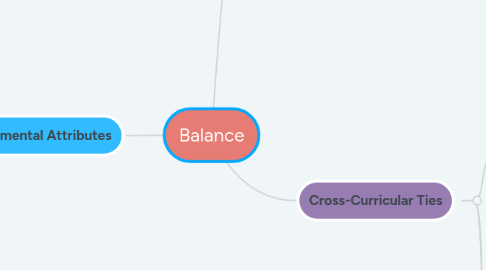
1. It has to do with the way different physical or conceptual elements affect and interact with one another to create a sense of stability.
2. Cross-Curricular Ties
2.1. Biology: Living Organisms and Homeostasis
2.1.1. Kinds of Living Organisms and what makes them living (In order for things to be living, they need to maintain equilibrium or homeostasis.)
2.1.1.1. Defining Features
2.1.1.1.1. Breathing
2.1.1.1.2. Energy Consumption
2.1.1.1.3. Growth
2.1.1.1.4. Eating
2.1.1.2. Correlational Features
2.1.1.2.1. Sleeping
2.1.1.2.2. Moving
2.1.1.2.3. Talking or making noise
2.1.1.3. Exemplars (Positive Instances)
2.1.1.3.1. Trees
2.1.1.3.2. Puppies
2.1.1.3.3. Rose bushes
2.1.1.3.4. Humans
2.1.1.3.5. Roaches
2.1.1.3.6. Spiders
2.1.1.4. Prototypes
2.1.1.4.1. Dogs
2.1.1.4.2. People
2.1.1.4.3. Trees
2.1.1.5. Non-examples (Negative Instances)
2.1.1.5.1. Rocks
2.1.1.5.2. Cars
2.1.1.5.3. Dishes
2.1.1.5.4. Firewood
2.1.1.5.5. Toys
2.1.1.6. Possible Misconceptions
2.1.1.6.1. Overgeneralization
2.1.1.6.2. Undergeneralization
2.2. Fine Arts: Symmetrical and Asymmetrical Balance in Art
2.3. Physical Education: Yoga
2.4. Health: Balanced Nutrition
2.5. Math: Equivalent fractions and equations
3. Developmental Attributes
3.1. Gender
3.1.1. Boys
3.1.1.1. Boys will generally need something more interactive to work with. They will also want things that are more individual and competitive. There is also more of a need for movement inclusive activities.
3.1.2. Girls
3.1.2.1. Girls will generally need something more social in nature, such as group work, and will need more interaction with the teacher. They will not require as much movement as the boys and will likely be able to focus on a single task for longer.
3.2. Piagetian Developmental Level
3.2.1. Formal Operational Stage (age 11+)
3.2.1.1. They will be able to work more with hypothetical situations that contradict the world they know.
3.2.1.2. They will be able to decenter, as they have passed the concrete operational stage.
3.2.1.3. Students who have special needs or are a little younger will need more help and scaffolding.
3.3. Vygotsky
3.3.1. Children will need scaffolding from the teacher to help them learn effectively (Zone of Proximal Development). Some will need more than others depending on background knowledge and whether or not they have special needs or learning disabilities.
3.4. Age Range: 11-13
3.4.1. Attention Span: 20-40 minutes
3.5. Relevance
3.5.1. Interest in the topic
3.5.2. Real-world applicability
